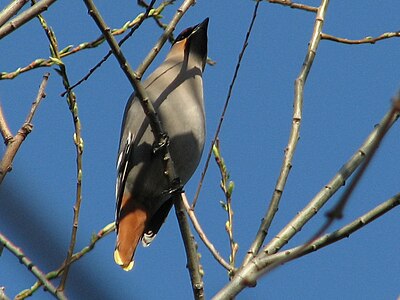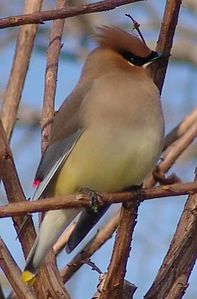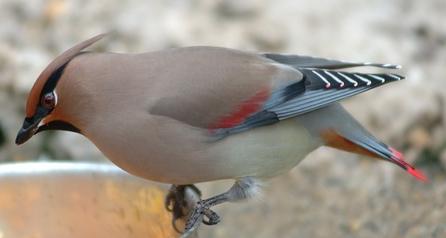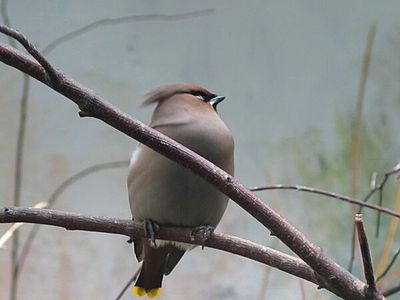Bombicilo
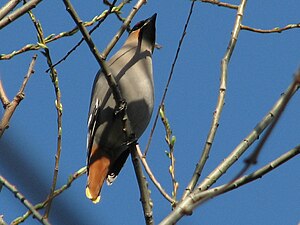 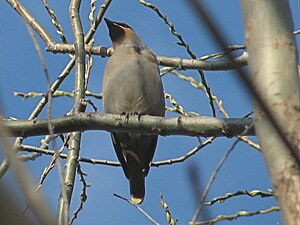 | ||||||||||||
| Biologia klasado | ||||||||||||
| ||||||||||||
 Natura arealo
| ||||||||||||
Aliaj Vikimediaj projektoj
| ||||||||||||
La eŭropa bombicilo, Garola bombicilo aŭ simple Bombicilo (Bombycilla garrulus) estas membro de la familio de Bombiciledoj en ties ununura genro kaj en la ordo de paseroformaj birdoj. Ĝi estas brila birdo, 18–21 cm longa kun starigebla kresto; ĝi veturas en grandaj, nomadaj grupoj per forta, rekta flugo. Ili reproduktiĝas en koniferaj arbaroj tra plej nordaj partoj de Eŭropo, Azio kaj okcidenta Nordameriko. Dum la Amerika bombicilo (vidu la suban foton) loĝas nur en Nordameriko kaj la Japana bombicilo (vidu la suban foton) loĝas nur en Azio, la eŭropa bombicilo estas la ununura membro de tiu familio kies teritorio ĉirkaŭas ĉiujn kontinentojn juste sub la subarktaj latitudoj.
Anglaj nomoj (kaj eventuale en aliaj lingvoj) aludas al ruĝaj makuletoj de flugiloj kiel vaksogutoj aŭ al supozebla deveno de la birdoj el Bohemio, ne kiel la reala regiono ekzistanta, sed kiel malproksima orienta lando.
Aspekto
[redakti | redakti fonton]
Ĝi estas pli granda kaj griza ol la amerika bombicilo, kun salmoroza koloro sube kaj bruneca supre. Ĝi havas brilflavan pinton en vostoplumoj kaj flavan aŭ blankan striecon en flugiloj. Kaj beko kaj piedoj estas malhelaj. Pli precize en kapo rimarkindas starigebla kresto kaj du nigraj areoj, el kiuj unu kovras la mentonon kaj la alia estas nigreca masko traokula kiu estas inter tre markata bruna frunto kaj alia bruneca areo sube sub la okulo inter ambaŭ nigrecaj areoj. Tiuj brunaj areoj nuanciĝas al helgrizbruna de kresto aŭ dorso. Krome estas du tre kontrastaj kvankam ne tre markataj blankaj markoj kaj sub la okulo kaj kiel muŝtaĉa strio pli videbla inter ambaŭ nigrecaj areoj.
La subaj partoj estas de tre bela koloro inter helgriza, rozkolora kaj salmokolora, dum la subvosto (anusa areo) estas klare markata brikruĝa. En subaj partoj inter brunecaj flugiloj rimarkindas helgriza pugo kiu nuanciĝas laŭ samkolora vosto al nigreca antaŭfino kaj tre rimarkinda brilflava larĝa finostrio. La plej alvoka parto estas koloraj markoj en flugiloj kiel flavaj al blankaj bordoj krom brilruĝaj rimarkindaj makuletoj ofte sub blanka pli granda marko.
Reproduktado
[redakti | redakti fonton]
Bombiciloj konstruas siajn nestojn alte en betuloj aŭ pinglarboj, sed ĉiukaze manĝodisponeblo sugestas la precizan lokon; ili konstruas ĝin per musko, herbo kaj lanugo. Ĉiu birdo aŭ paro povas havi pli da unu nesto en la sama ĝenerala areo. La nestoj havas eksteran diametron de 15 cm al 18 cm. Dum la monatoj majo-junio ili demetas averaĝe 4 ĝis 6 ovojn, kiuj estas palbluecaj kun nigrecaj punktoj kaj malhelaj neregulaj linioj. Kovado daŭras ĉirkaŭ 14 tagojn kaj elnestiĝo okazas ĉirkaŭ 13 al 15 tagojn post eloviĝo.
Kutimaro
[redakti | redakti fonton]Somere bombiciloj vivas en la nordo de Skandinavio kaj en Siberio. Tie ili manĝas insektojn (ĉefe dum la reprodukta sezono) kaj nuksojn. Dum la vintro ili transiras al beroj de la birdokaptista sorbuso, kratago kaj mespilo. Tiu specio estas ekaperanta, kaj moviĝas laŭ neantaŭvideblaj migrovojoj el jaro al jaro, kaj ĉefe moviĝas suden, ofte en grandaj nombroj, se la berodisponeblo falas vintre.
La alvoko estas agrabla ringosono, simila al tiu de la Amerika bombicilo sed pli malaltatona.
Birdoj vintre povas esti fidemaj kaj eniras en ĝardenoj serĉe de beraj arbustoj kaj arboj, kaj ĉefe ili preferas la sorbuson.
Nomo
[redakti | redakti fonton](Bombycilla, la genra nomo, estas klopodo de Vieillot por fari latinan nomon por "silkovosto", tradukante la germanan nomon Seidenschwänze.)[1] La specinomo garrulus signifas 'bruema' aŭ 'kverelema' alude al la epokoj kiam ili ariĝas.
Genro kaj specioj
[redakti | redakti fonton]- Bombicilo (Bombycilla)
- Eŭropa bombicilo, garola bombicilo, bombicilo (Bombycilla garrulus)
- Amerika bombicilo, cedra bombicilo (Bombycilla cedrorum)
- Japana bombicilo (Bombycilla japonica)
Bildogalerio
[redakti | redakti fonton]-
Eŭropa bombicilo, masklo (Bombycilla garrulus)
-
Amerika bombicilo (Bombycilla cedrorum)
-
Japana bombicilo (Bombycilla japonica)
-
Bombicilo
Referencoj
[redakti | redakti fonton]- ↑ Vieillot miskomprenis motacilla, latina por "motacilo", kiel mota por "movo" kaj cilla, kion li missupozis "vosto". (Motacilla fajte kombinas motacis, movanto, kun la diminutiva sufikso -illa.) Li do kombinis tiun cilla kun la latina bombyx, silko (Holloway 2003).
Literaturo
[redakti | redakti fonton]- IUCN2006, BirdLife International, 2004, 51515, Bombycilla garrulus, 12a Majo 2006. Malplej zorgiga.
Eksteraj ligiloj
[redakti | redakti fonton]- Retejo de la Cornell University Ornithological Lab pri la Eŭropa bombicilo, inklude kantekzemplojn
- USGS Retejo pri la Eŭropa bombicilo Arkivigite je 2013-06-04 per la retarkivo Wayback Machine
- Filmetoj, fotoj kaj sonoj pri la Eŭropa bombicilo ĉe Internet Bird Collection
- South Dakota Birds – Informaro kaj fotoj pri la Eŭropa bombicilo
- pri la Eŭropa bombicilo, Environment Canada
Libroj
[redakti | redakti fonton]- Witmer, M. C. 2002. Bohemian Waxwing (Bombycilla garrulus). In The Birds of North America, No. 714 (A. Poole and F. Gill, eds.). The Birds of North America, Inc., Philadelphia, PA.
Tezoj
[redakti | redakti fonton]- Burns JB. M.S. (2000). Sexual dichromatism in Bohemian waxwings. Utah State University, United States—Utah.
- Howell JC. Ph.D. (1973). COMMUNICATIVE BEHAVIOR IN THE CEDAR WAXWING (BOMBYCILLA CEDRORUM) AND THE BOHEMIAN WAXWING (BOMBYCILLA GARRULUS). University of Michigan, United States—Michigan.
Artikoloj
[redakti | redakti fonton]- Babo T. (1981). Mass Occurrence of the Waxwing Bombycilla-Garrulus in the District of Nitra Slovakia Czechoslovakia and Its Close Surroundings. Zbornik Slovenskeho Narodneho Muzea Prirodne Vedy. vol 27, p. 141-146.
- Berthold P. (1976). The Waxwing Bombycilla-Garrulus as a Frugivorous Feeding Specialist. Experientia. vol 32, no 11.
- Bojanski T. (1967). Mass Appearance of Bohemian Waxwing Bombycilla-Garrulus in Old City Stare Miasto Warsaw Poland. Notatki Ornitologiczne. vol 8, no 2-3. p. 61-62.
- Borowski S. (1966). On the Food of the Bohemian Waxwing Bombycilla-Garrulus Mistletoe-D Snowberry-D Wayfaring-Tree-D. Przeglad Zoologiczny. vol 10, no 1. p. 62-64.
- Car Z. (1973). The Spring Migration of the Waxwing Bombycilla-Garrulus in 1954. Larus. vol 10, no 1973.
- Cornai R. (1980). Waxwings Bombycilla-Garrulus in Backa Voivodina in 1954. Larus. vol 8.
- Cvitanic A. (1958). Observation of the Waxwings Bombycilla-Garrulus Nutrition in Captivity. Larus. vol 13, p. 49-50.
- Cvitanic A. (1960). Characters of Specimens of Waxwing Bombycilla-Garrulus Collected in Croatia Slovenia Serbia and Vojvodina. Larus. vol 14, p. 121-126.
- Dathe H. (1992). Another note on reports of waxwing Bombycilla garrulus in Italy 1946/1947. Beitraege zur Vogelkunde. vol 38, no 4.
- De Juana E. (2005). Report on rare birds in Spain in 2003. Ardeola. vol 52, no 1. p. 185-206.
- Dorning H. (1980). Unusual Feather Ornament of the Waxwing Bombycilla-Garrulus-Garrulus. Larus. vol 3, no 49.
- Durnev Yu A, Lipin SI, Sirokhin IN & Sonin VD. (1982). An Experiment in Studying Bird Diet Using Fecal Analysis. Biologicheskie Nauki. vol 9, p. 103-107.
- Englund R. (1993). Fruit removal in Viburnum opulus: Copious seed predation and sporadic massive seed dispersal in a temperate shrub. Oikos. vol 67, no 3. p. 503-510.
- Erard C. (1967). Irruption of Chatterers Bombycilla-Garrulus in France in 1965-1966. Alauda. vol 35, no 4. p. 270-287.
- Eriksson K & Nummi H. (1983). Alcohol Accumulation from Ingested Berries and Alcohol Metabolism in Passerine Birds. Ornis Fennica. vol 60, no 1. p. 2-9.
- Fernbach J. (1960). Waxwings Bombycilla-Garrulus in Winter 1959-1960 in Subotica. Larus. vol 14, no 154.
- Fischer W, Minnemann D, Grummt W, Dathe H & Creutz G. (1975). A Conspicuous Return of the Waxwing Bombycilla-Garrulus to the Berlin Area in the Spring of 1972. Beitraege zur Vogelkunde. vol 21, no 6. p. 492-493.
- Fouarge J & Vandevondele P. (2005). Synthesis on the exceptional invasion of Waxwings (Bombycilla garrulus) in Europe in 2004-2005. Aves. vol 42, no 4. p. 281-311.
- Fouarge J & Vandevondele P. (2006). The Waxwings (Bombycilla garrulus) during the 2004-2005 invasion. Analysis of Belgian and Luxemburg data. Notes on behavior in Belgium and Europe. Aves. vol 43, no 3. p. 129-156.
- Grubbe O. (1971). Further Observations on the Bohemian Waxwing. Gefiederte Welt. vol 95, no 8. p. 153-154.
- Harmata W. (1987). On Food in Waxwing Bombycilla-Garrulus L. Field and Laboratory Observations. Przeglad Zoologiczny. vol 31, no 3. p. 359-364.
- Hilden O. (1977). Occurrence of Irregular Migrants in Finland in 1976. Ornis Fennica. vol 54, no 4. p. 170-179.
- Houston CS. (1968). Bohemian Waxwing Banding. Ring International Ornithological Bulletin. vol 55, p. 116-118.
- Hummel ER. (1971). The 1st Waxwings Bombycilla-Garrulus. Gefiederte Welt. vol 95, no 12.
- Jacob J-P. (1996). Invasion of waxwings (Bombycilla garrulus) in the beginning of 1996 in Wallonia and in Brussels. Aves. vol 33, no 3. p. 137-152.
- James PC, Smith AR, Oliphant LW & Warkentin IG. (1987). Northward Expansion of the Wintering Range of Richardson's Merlin. Journal of Field Ornithology. vol 58, no 2. p. 112-117.
- Johnson JW. (1970). Bohemian Waxwing Ceremony at Huron. South Dakota Bird Notes. vol 22, no 3. p. 103-104.
- Kalden G. (2003). [Observations of Bombycilla garrulus in the winter of 2002-03.]. Vogelkundliche Hefte Edertal. vol 29, p. 55-58.
- Kalden G. (2005). Largest Bohemian waxwing invasion (Bombycilla garrulus) in forty years. Vogelkundliche Hefte Edertal. vol 31, p. 68-71.
- Keve A. (1972). 2 Year Waxwing Bombycilla-Garrulus-Garrulus Invasion. Larus. vol 5, p. 53-60.
- Keve A. (1980). 10 Year Study of Waxwing Bombycilla-Garrulus Invasions in Hungary and in the Carpathian Basin 1938-1939 1947-1948. Larus. vol 3, p. 43-47.
- Klein B. (1971). Bombycilla-Garrulus and Nucifraga-Caryocatactes. Alauda. vol 39, no 1. p. 78-79.
- Koenig WD & Knops JMH. (2001). Seed-crop size and eruptions of North American boreal seed-eating birds. Journal of Animal Ecology. vol 70, no 4. p. 609-620.
- Kollar HP & Seiter M. (1991). Irruption of the Waxwing Bombycilla-Garrulus in the Riverside Forests Along the Danube Austria East of Vienna in 1988-89 and 1989-90. Egretta. vol 34, no 1. p. 42-49.
- Kolunen H & Vikberg P. (1978). Migrations of the Waxwing Bombycilla-Garrulus 1969-1977 Paijat-Hame. Ornis Fennica. vol 55, no 3. p. 126-131.
- Krauss W. (1972). Report on the Waxwing Bombycilla-Garrulus 1970-71 Invasion in Bavaria. Anzeiger der Ornithologischen Gesellschaft in Bayern. vol 11, no 1. p. 54-57.
- Kroneisl R. (1971). Waxwings Bombycilla-Garrulus in the Winter of 1947-1948. Larus. vol 2, no 113.
- Kroneisl R. (1980). Occurrence of Waxing Bombycilla-Garrulus in Yugoslavia in 1949. Larus. vol 3, no 281.
- Kumerloeve H. (1980). Invasion of the Waxwing Bombycilla-Garrulus During the Winter of 1941 1942. Larus. vol 8.
- Milberg P & Tyrberg T. (1990). Do the Feeding Habits of Birds Determine the Distribution of Mistletoe Viscum-Album in Sweden. Fauna och Flora Naturhistoriska Riksmuseet. vol 85, no 6. p. 253-259.
- Moltoni E. (1971). The Appearance of the Bohemian Waxwing Bombycilla-Garrulus in Italy in 1970-1971. Rivista Italiana di Ornitologia. vol 41, no 3. p. 150-160.
- Moltoni E. (1974). Notes on the Appearance in Italy of the Bohemian Waxwing Bombycilla-Garrulus-Garrulus in 1971-1972 with Accompanying Data on Incursions During Recent Years. Rivista Italiana di Ornitologia. vol 44, no 3. p. 197-205.
- Moltoni E & Brichetti P. (1976). Note on the Appearance in Italy of the Bohemian Waxwing Bombycilla-Garrulus in 1974-1975 and 1975-1976 Fall and Water Seasons. Rivista Italiana di Ornitologia. vol 46, no 1. p. 24-32.
- Nankinow D. (1993). Invasion of waxwings (Bombycilla garrulus L.) in Bulgaria and considerations on its spreading to eastern Europe. Beitraege zur Vogelkunde. vol 39, no 6. p. 361-375.
- Peck MK, Coady G, Binsfeld G & Konze KR. (2004). First documented nest record of Bohemian Waxwing in Ontario. Ontario Birds. vol 22, no 1. p. 9-14.
- Pelle I. (1969). Waxwings Bombycilla-Garrulus in the Banat Yugoslavia in Winter 1970-71. Larus. vol 23, no 207.
- Pelle I. (1980). Waxwings Bombycilla-Garrulus in Stara Kanjiza in Winter 1953 1954. Larus. vol 8.
- Petersen MR, Weir DN & Dick MH. (1991). Birds of the Kilbuck and Ahklun Mountain Region Alaska. North American Fauna. vol 76, p. 1-158.
- Plath L. (1983). Kestrel Falco-Tinnunculus Kills Waxwing Bombycilla-Garrulus. Beitraege zur Vogelkunde. vol 29, no 4. p. 247-248.
- Plini P. (1989). A Record of Waxwing Bombycilla-Garrulus in Latium Central Italy. Rivista Italiana di Ornitologia. vol 59, no 3-4. p. 309-310.
- Preuss NO. (1968). Influx of Waxwings Bombycilla-Garrulus in Denmark 1965-1966. Dansk Ornitologisk Forenings Tidsskrift. vol 62, no 2. p. 105-125.
- Preuss NO. (1969). Influx of Waxwings Bombycilla-Garrulus in Denmark 1966-1967. Dansk Ornitologisk Forenings Tidsskrift. vol 63, no 1. p. 45-49.
- Ptaszyk J. (2004). Numbers, phenology and diet of the Waxwing Bombycilia garrulus in Poznan in 1966/1967-1995/1996. Notatki Ornitologiczne. vol 45, no 4. p. 229-240.
- Rafajlovic A. (1972). Incidence of Waxwings Bombycilla-Garrulus in Subotica in 1958. Larus. vol 11, no 120.
- Reichholf-Riehm H. (1972). Daytime Distribution of Foraging in Waxwings Bombycilla-Garrulus in Southeastern Bavaria During the Invasion of 1970-1971 and 1971-1972. Anzeiger der Ornithologischen Gesellschaft in Bayern. vol 11, no 2. p. 190-193.
- Rucner D. (1958). Waxwing Bombycilla-Garrulus Invasion of Yugoslavia in Winter 1958-1959. Larus. vol 13, p. 205-206.
- Rucner D. (1960). Occurrence of the Waxwing Bombycilla-Garrulus at the Beginning of 1960 in Croatia. Larus. vol 14, no 154.
- Rucner D. (1970). On the Occurrence of the Waxwing Bombycilla-Garrulus in the Beginning of 1972 in Croatia. Larus. vol 24, no 163.
- Rucner D. (1972). Waxwings Bombycilla-Garrulus in Yugoslavia at the Beginning of 1958. Larus. vol 11, p. 119-120.
- Rucner D. (1974). Incidence of the Waxwing Bombycilla-Garrulus in Croatia at the Beginning of 1972. Larus. vol 24, no 1974.
- Rucner D. (1980). Waxwing Bombycilla-Garrulus in the Zagreb Area in 1953 and 1954. Larus. vol 8.
- Rucner R. (1969). Waxwings Bombycilla-Garrulus in Winter 1970-1971 in Zagreb Yugoslavia. Larus. vol 23, no 207.
- Sammalisto L. (1977). The Winter Bird Census in 1976-1977. Ornis Fennica. vol 54, no 3. p. 127-132.
- Sammalisto L. (1978). Finnish Winter Birds in 1977-1978. Ornis Fennica. vol 55, no 4. p. 164-170.
- Sammalisto L. (1980). Winter Birds in the Census 1979-1980. Ornis Fennica. vol 57, no 4. p. 167-172.
- Sammalisto L. (1981). Census of the Finnish Winter Birds in 1980-1981. Ornis Fennica. vol 58, no 4. p. 167-174.
- Scheifler HJ. (1972). Further Observations of Waxwings Bombycilla-Garrulus. Gefiederte Welt. vol 96, no 3.
- Skoracki M. (2002). Three new species of the ectoparasitic mites of the genus Syringophiloidus Kethley, 1970 (Acari: Syringophilidae) from passeriform birds from Slovakia. Folia Parasitologica. vol 49, no 4. p. 305-313.
- Spicer GS. (1978). A New Species and Several New Host Records of Avian Nasal Mites Acarina Rhinonyssinae Turbinoptinae. Journal of Parasitology. vol 64, no 5. p. 891-894.
- Stromar L. (1970). Incidence of the Waxwing Bombycilla-Garrulus in Yugoslavia in Winter 1965-1966. Larus. vol 20, p. 41-52.
- Stromar L. (1970). Incidence of the Waxwing Bombycilla-Garrulus on the Territory of Croatia During 1966-1967 and 1967-1968. Larus. vol 20, no 97.
- Tutman I. (1980). Waxwings Bombycilla-Garrulus in Dubrovnik in 1954. Larus. vol 8.
- Van Der Elst D. (1986). On the Status of the Bohemian Waxwing Bombycilla-Garrulus in Walloon and Brussels Belgium. Aves. vol 23, no 4. p. 254-256.
- Voronov NP & Voronov LN. (1978). Morphometric Study of the Digestive System of the Waxwing Bombycilla-Garrulus Aves Bombycillidae. Vestnik Zoologii. vol 5, p. 28-31.
- Warkentin IG & Oliphant LW. (1990). Habitat Use and Foraging Behavior of Urban Merlins Falco-Columbarius in Winter. Journal of Zoology. vol 221, no 4. p. 539-564.
- Wunderlich K & Von Vietinghoff-Scheel E. (1975). Waxwings Bombycilla-Garrulus in Moscow in Late Winter. Beitraege zur Vogelkunde. vol 21, no 6.
- Yocom CF. (1970). Bohemian Waxwing Invasion of Humboldt County California 1969. Murrelet. vol 51, no 2. p. 21-22.
- Zink G. (1969). Banded Bohemian Waxwings Bombycilla-Garrulus of the Invasion of 1965 to 1966 Which Were Found Again. Bonner Zoologische Beitraege. vol 20, no 1-3. p. 191-199.
- Zinnenlauf B. (1969). The Arrival of Bombycilla-Garrulus in the Winter 1967-1968 in Switzerland. Ornithologische Beobachter. vol 66, no 1. p. 15-16.
| ||||||||||||||||||



